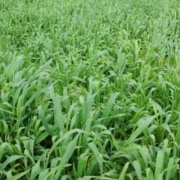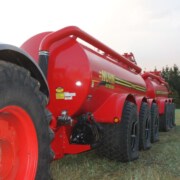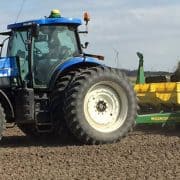For unseeded fields, the key benefits of cover crops are weed suppression, soil protection from sun and rain, and building organic matter. They can also be source of forage and bedding.
When selecting a cover crop consider the cropping system needs, herbicide or fertilizer previously applied and resources that are readily available. For example, carrying over treated soybean seed is not considered a good practice in Ontario due to the potential for significant decline in germination. Treated soybean seed can make a good addition to a cover crop planting.
Cropping system needs
Field will be planted to winter wheat in the fall of 2019
Cover crop options
- Oats Seed at 30 to 50 lbs per acre. Use the higher end of the seeding range if broadcasting and incorporating the seed. Oats are less likely than barley to carry disease to the succeeding wheat crop.
- Combine oats (30 to 50 lbs/acre) with leftover treated soybean seed Spread the soybean seed out across the acres to be planted.
- Oats (25-30 lbs/acre) and daikon radish (no more than 2 lbs/acre)
Control the cover crop two weeks prior to seeding winter wheat.
Alternatively, there is the option to plant nothing, and leave the field bare. Weeds would be controlled through herbicides or tillage, but both of these options cost money, won’t protect the soil from rain and sun damage and are less effective at managing weeds than cover crops in combination with herbicides.
Field NOT intended for winter wheat in the fall of 2019
Cover crop options
- Oats Seed at 30 to 50 lbs per acre. Use the higher end of the seeding range if broadcasting and incorporating the seed.
- Combine oats (30 to 50 lbs/acre) with leftover treated soybean seed Spread the soybean seed out across the acres to be planted.
- Oats (25-30 lbs/acre) and daikon radish (no more than 2 lbs/acre). Daikon radish (i.e. Tillage radish, Nitro radish, etc.) will be slow to flower but if flowers are observed the cover crop should be mowed or terminated to prevent seed set.
- Oats (25-30 lbs/acre) and Clover (3 lbs/acre). Crimson clover will flower and rarely over winter. Double cut red clover will over winter if not terminated.
Cover crops planted in early July have the potential for significant top growth by fall and in the case of radish, seed set. Manage cover crops or terminate to avoid seed set and potential weed problems next year.
All of these cover crop options will respond well to manure application and will scavenge nutrients.
Forage is required for feed and spring seeding was impossible
Tonnage is needed
- Decide whether you think this summer will be hot/dry or cool/wet. Expected weather conditions change which crop is most likely to be high-yielding.
- Usually July is hot. Warm-season annual grasses (sorghum, sorghum-sudangrass, sudangrass, millet, etc.) will grow rapidly with heat. They have a reputation for being low-quality, but this is generally a result of using a one-cut system; yields and quality are maximized in a two-cut system. Warm-season annual grasses are ready to harvest approximately 60 days after planting, which puts us into the first week of September. Growth rates will slow as the temperature drops, and warm-season annuals will be killed by frost. It is possible that only one-cut will be realized this late in the year. Application of nitrogen fertilizer will be needed.
- After the first cut from a warm-season grass (early September), growers could plant fall rye or winter triticale. This can be grazed 7 weeks after seeding (late October) or early in early spring, or be harvested in May at flag-leaf or boot stage. There is the opportunity to follow with silage corn or perennial forages.
- If the long-term forecast looks like it will stay cool and wet, Italian Ryegrass (IRG) can produce yields comparable to sorghum-sudangrass under hot/dry conditions. Plant into moisture, first cut is about 6-8 weeks later, subsequent cuts every 28 days or so.
Digestible fibre/energy is needed
- Cereals can be ensiled at boot stage or at soft dough stage. Plant oats now through August. Harvest 45-60 days later. Boot stage feeds like a haylage, soft dough stage will feed out more like silage corn.
- Italian Ryegrass plant in August, take first cut in October.
Protein is needed
- Planting peas with cereals can increase the protein content. Peas do not work well on their own because they tend to fall over and make harvest difficult. Ideally the peas and cereals should have the same number of days until flower. However, if there is a difference in maturity (caused by varieties or weather), harvest when the cereal is at boot stage to maximize quality.
- Red clover seed is usually relatively inexpensive. While it is hard to dry as hay, red clover makes good silage with the colour slightly darker than alfalfa. Plant in August, harvest in October.
- Annual clovers may be able to provide needed protein. Berseem is suited to production in wet soils, while crimson prefers good drainage. Plant in August.
Options for grazing
Almost anything can be grazed. In addition to the above options, consider adding forage brassicas (rape, kale, turnip, radish, etc.) to a mix for increased protein. Brassica leaves do not dry and store well; most producers do not have equipment to harvest roots for storage. Crop residues can provide good grazing for mature animals with low maintenance requirements. Avoid hairy vetch, buckwheat, and mustard in mixes to be grazed.
If straw is needed for bedding or as fibre in feed rations, any spring cereal can produce straw. Spring triticale or rye will produce more straw than oats while barley will produce slightly less. Spring cereals seeded this late in the season do not tiller well. Seed at 75 to 80 lbs/acre. The crop will need 30 to 50 lbs of actual nitrogen to achieve good growth. Plan to desiccate ten days after heading to prevent grain formation and aid in baling.
Other considerations
How you plant the cover crop will also depend on your goal with the cover crop. If you are looking for cover crops to provide forage use a drill to seed to ensure even placement and faster more consistent establishment. If the goal is to get soil covered quickly, broadcast seed and use light tillage to cover the seed. It may seem to be faster to just broadcast seed but this leaves germination dependent on surface moisture, which can disappear quickly in summer conditions. Herbicide residues may be of concern in some fields. The following link provides more information on cover crop sensitivity to herbicide residues https://www.country-guide.ca/crops/pest-patrol-planning-for-cover-crops/.
Cover crop seed availability can vary regionally, check with local suppliers or find a supplier at http://www.omafra.gov.on.ca/english/crops/resource/covercrp.htm.
Source: OMAFRA Field Crop Team Field Crop News



 CleanFarms
CleanFarms




